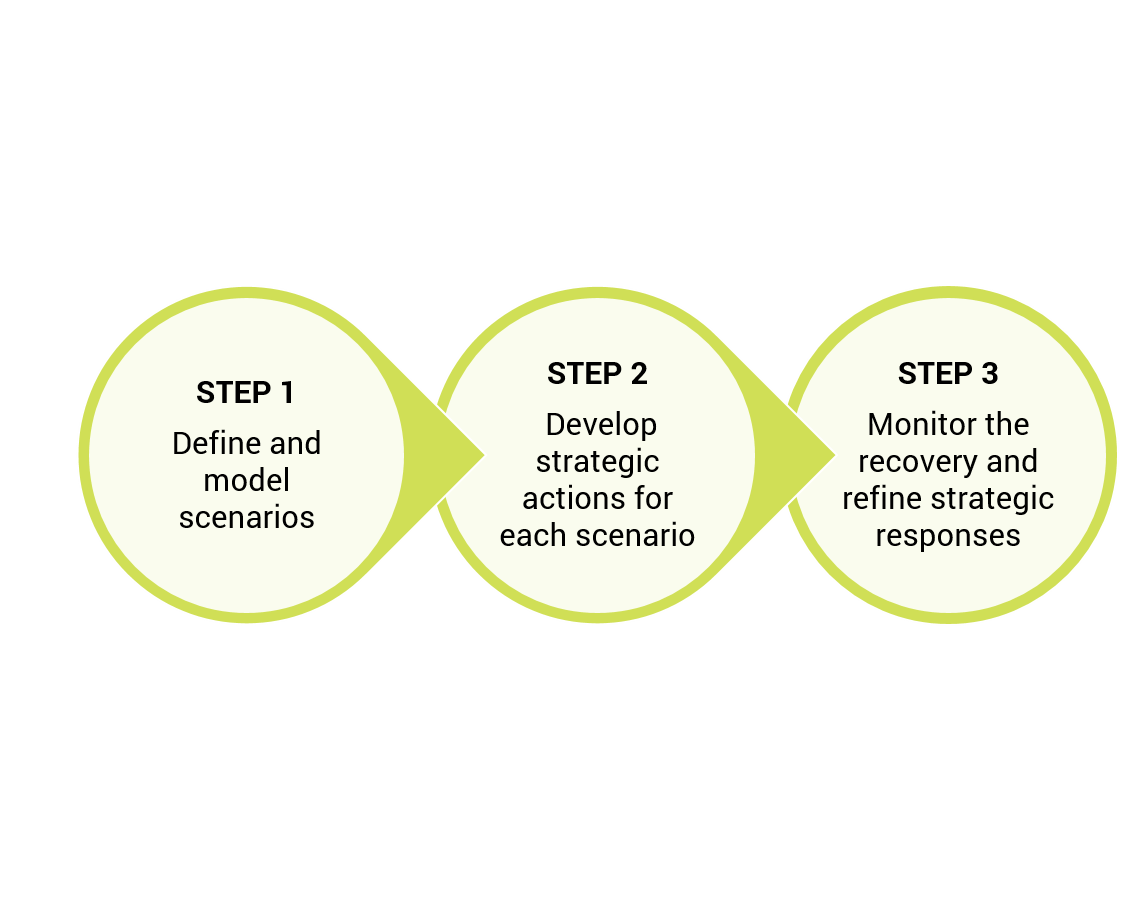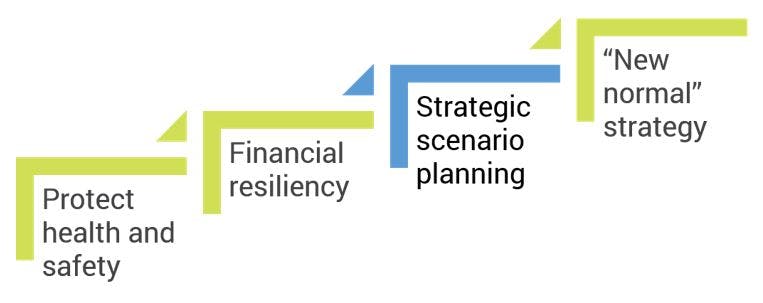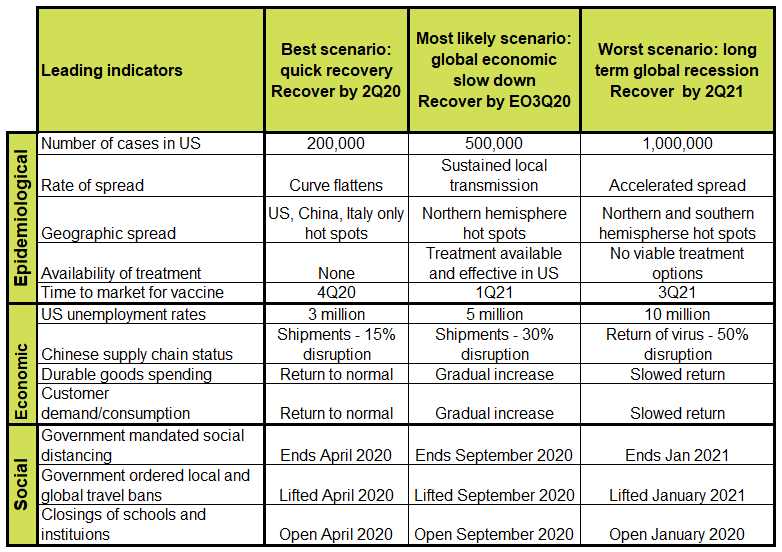

Strategic scenario planning enables business recovery
With the COVID-19 pandemic spreading across the country business leaders must focus on the “now” to protect the health and safety of their employees, customers, suppliers and other stakeholders while beginning to plan for a new “tomorrow”.
Uncertainty about the near and long-term future of our economy and individual businesses is the only constant. Navigating the near, medium and long-term future goals will be crucial to protect the value of the enterprise and to rethink plans to enhance value in a “new normal” environment.
Baker Tilly has developed a coronavirus resource center to help business leaders take appropriate actions to ensure near-term survival and eventual long-term success.
Where strategic scenario planning fits into your response to the coronavirus:
It goes without saying that the foremost priority is the health, safety and well-being of your company’s stakeholders. As of this publication date, most companies have addressed these concerns and are now moving quickly to create a remote work environment or maintain safe facilities.
As the economy continues to slow down in the aftermath of COVID-19, the next priority for businesses is to understand their cash position and working capital needs — especially if there is a need to recapitalize the business. Baker Tilly has developed a 13-week cash flow modeling tool that will provide a detailed view of cash inflows, outflows and the ability to meet obligations as they come due. The model empowers management, lenders and investors to make decisions impacting immediate and near term cash flows.
Companies must stabilize their financial position and then revisit their current strategic plans. Most management teams have built their strategies on a set of assumptions that include sustained economic growth, the availability of capital, tight labor markets and other market factors that have been consistent in recent years. It is not an exaggeration to suggest that these assumptions can be thrown out the window. Your business strategy should be revised quickly and include a new set of assumptions that consider the current macro-economic market.
Since it will be difficult to predict what will happen next, we recommend developing a few strategic scenarios based on informed assumptions and a set of go-forward strategic actions for each situation.
Introduction to strategic scenario planning
The coronavirus crisis has created enormous uncertainties regarding its impact on the global economy. Many business will either wait too long to react or act rashly by making extreme changes to their business model and cost structure. We recommend taking a thoughtful and expeditious approach to addressing the crisis. Several scenarios can be defined based upon how severe it could still become, when it will end and what the new business environment that emerges will be like when it does end.
For businesses to be successful in planning a future course of action in this fluid environment, we recommend using a strategic scenario planning process. Strategic scenario planning is a technique developed and used by the military to define key operational and strategic dimensions that would require specific actions depending on different scenarios. Strategic scenario planning allows a business to address uncertain futures by defining and prioritizing strategic actions — knowing that the priorities and subsequent strategic actions may shift as certain indicators in the external environment change.
In the case of the COVID -19 crisis, those factors may fall into three categories:
- Epidemiological factors – the number, growth rate and timing of the spread of cases
- Economic factors – supply chain disruptions, demand declines, unemployment rates
- Social factors – government or quarantine orders
Business owners can use strategic scenario planning to make assumptions on how the crisis will play out and how the business environment will change over time. This helps develop a set of tactical and strategic actions to address the uncertainties as they become realities.
Baker Tilly’s strategic scenario planning process
We recommend a three-step process for strategic scenario planning to define the potential strategic response to the COVID-19 crisis.

Step 1: Define and model scenarios
What remains uncertain amid this global pandemic is its duration, severity and timing for financial recovery. All we can do is make informed assumptions on how these uncertainties will impact the overall economy, as well as individual businesses. Several different outcomes are possible depending on how these uncertainties unfold.
A business may find that it has multiple scenarios as it develops its strategy to address the crisis. It is the company’s responsibility to define its unique scenarios and then model the potential impacts of each scenario on the business. Each scenario will represent a different macro-environmental scenario, which will require a different strategic response.
The first step in strategic scenario planning is to identify these plausible scenarios and assess their relative likelihood of occurrence. We recommend planning around three key scenarios:
- Best case
- Worst case
- Most likely
It should be noted, as the environment is very fluid, the parameters of these scenarios may change quickly.
The process to define the scenarios involves:
- Identifying the driving forces or key leading indicators that will impact future scenarios
- Creating a set of assumptions, performance ranges and triggers around the key indicators to begin to define scenarios
- Prioritizing the driving forces that represent the most critical uncertainties as to how the future environment will change
- Developing example scenarios based upon the assumptions regarding how the uncertainties resolve themselves over time
Examples of key leading indicators by category are:
Epidemiological
- Number of cases
- Rate of spread
- Mortality rate
- Geographic spread
- Availability/timing of treatment options
- Time to market for vaccine
Economic
- Customer demand reductions
- Unemployment numbers
- Late payment/default by customers
- Continued supply disruptions
- Durable goods spending
- Forced behavior changes by workers and consumers
- Government assistance programs
Social
- Government-ordered travel bans
- Government shutdowns of non-essential business
- Closings of schools, cultural institutions and recreation facilities
Examples of scenarios and leading indicators
* This chart is for illustrative purposes only
Once the scenarios are defined, models should be created to simulate the financial impacts of the leading indicators on each scenario.
For each scenario, profit and loss statements, balance sheets and cash flow statements should be created and stress-tested to understand the financial differences of each scenario.
Step 2: Develop strategic actions for each scenario
Once the scenarios are defined and leading indicators are quantified, a set of strategic actions should be defined for each scenario.
Now is not the time to begin a lengthy strategic planning process. For each scenario, quickly, but thoughtfully, define a portfolio of potential strategic actions. Organize the portfolio of actions around strategic themes that are relevant to the business’s financial survival and recovery during this crisis.
The strategic themes should include:
- Customer demand generation – how to regenerate or create new customer demand
- Supply chain stabilization – de-risking the supply chain and ensure future stability
- Employee health, safety and retention – keeping employees safe and retaining them for the future
- Financial resilience – ensuring that the business takes the proper near-term actions to maintain solvency
- Business model rationalization – changing the business model to reflect the current economic environment and eliminating non-essential operations to maintain financial viability
- Cybersecurity – safeguarding the security of a remote work force
The strategic themes identified above should help businesses address and prioritize the actions that are required to respond to the crisis situation in order to preserve and eventually enhance enterprise value.
For each theme, a set of short-term and medium-term objectives and supporting strategic actions should be defined. For each action, milestone, performance metric, responsibilities and resources should also be defined.
The portfolio of strategic actions for each scenario should establish a roadmap for the business to:
- Stabilize the current financial situation
- Prepare for the post-crisis “new normal”
The best-managed companies will also use the crisis as an opportunity to get closer to their customers through digital access, establish differentiated customer value, expand market share and create new competitive barriers. If the appropriate strategic actions are taken during the crisis, the company will be better positioned for growth in revenue and profitability when the economy bounces back.
Step 3: Monitor the recovery and refine strategic responses
After the strategic scenarios have been defined, the appropriate scenario has been selected and the portfolio of strategic actions are being implemented, it is important for management to continue to monitor the recovery and refine the strategic responses if the leading indicators change and the assumption set is no longer valid.
According to research conducted on 10,000 global companies by Dr. Mark Frigo, Distinguished Professor Emeritus at DePaul University’s Kellstadt Graduate School of Business, a common practice of the “best performing” companies is a continued vigilance to the forces of change in the world economy.
Continued vigilance is even more important now than ever before given the changing external environment. The crisis situation is fluid, dynamic and not predictable. There is no guarantee that the “most likely” scenario that we identify today will not turn into the “least likely” scenario in one, three or six months.
A vigilance to the assumption set that supports the chosen scenario is critical. Companies must be ready to zig or zag and go to “Plan B” or “Plan C”. Strategic scenario planning is a valuable technique for action planning in a hyper-uncertain economic environment.

Virtual strategic scenario planning
For Baker Tilly, the safety of your people and your business is paramount. We are committed to playing our part in containing COVID-19 by practicing responsible social distancing, while still delivering a high level of service. We can work with your team collaboratively using remote technology and video conferencing tools to guide you through our three-step strategic scenario planning process. The outcomes will be:
- Multiple scenarios identified
- Financial stress testing of each scenario
- A set of strategic actions defined for each scenario
- Execution assistance and monitoring for the chosen scenario
Rapid cash management and a 13-week cash flow diagnostic
Baker Tilly will work with your teams to develop a 13-week cash flow modeling tool that will provide a detailed view of cash inflows, outflows and the ability to meet obligations as they come due. The model will enable management, lenders and investors to make decisions impacting immediate and near term cash flows. Questions to be answered include:
- How far can our current cash flow position extend ongoing operations?
- How do we triage expenses?
- When may we need to implement changes to our workforce?
- Do we need to manage our non-essential suppliers differently?
- When do we discuss flexibility with our landlord?
- When do we approach our bank for debt leniency?
- When do we approach our investors for more capital?
- When do we apply for government assistance?
Supply chain disruption analysis
Baker Tilly’s supply chain specialists will conduct a supply chain and disruption spend analysis, allowing for preliminary conclusions and guidance regarding your supply chain risks and opportunities in navigating these uncharted waters. Issues to be addressed include:
- Current and anticipated disruptions and risks challenges within the supply chain
- System re-order point evaluation
- Demand anticipation factored into the short-term and long-term planning cycles
- Contingency planning regarding alternate supply base, near shoring or re-shoring
- Pricing analytics both up and down the supply chain
Navigating federal, state and local government assistance
Having visibility into the most current relief packages and government guidance will put your business in the best possible position to receive qualified assistance. We understand these programs are evolving every day and will provide you with the most recent information available.
Insurance plan reviews
As insurance carriers determine their approach to covering the business interruption associated with COVID-19, you need to understand your coverages and develop an approach to the discussions with your insurance carriers. Baker Tilly’s insurance industry professionals can guide you through this process.
Outsourced financial services
You may need an interim CFO or controller to provide financial support during this difficult time. Baker Tilly is prepared to provide those capabilities and professionals to augment your internal team.
Tax advisory
Our tax professionals can help you determine the tax implications at the federal, state and local levels and design a strategy to optimize the company’s tax position.
Fair market opinions and valuations
The valuation of business interests and related assets in the context of financial reporting, taxes and corporate transactions is at the center of many vital strategies and financial decisions. Baker Tilly can assist your company in understanding your current business status, and the necessary steps you’ll need to take to achieve your goals.



